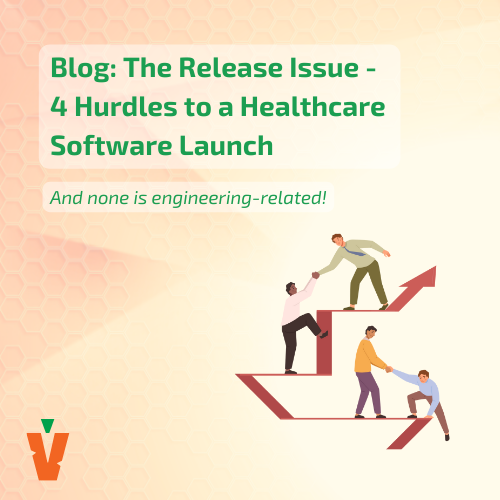How long does it take to build software for healthcare? Depending on the complexity and team size, the answer can be anywhere from three months to a year.
As you already know, there’s no ‘usual’ duration of healthcare projects. Everything from company size to engineering skills and user requirements will affect the final number. At Vitamin, we typically roll out software in stages, aiming to finalize an MVP in 3–4 months.
But the duration isn’t the key factor here — what matters most is that you release software when you said you would. Delays cost thousands in wasted resources and legal troubles, and even more in reputation loss.
Today, we examine a sample healthcare project timeline and everything that can disrupt it. Drawing from our eight years of industry experience, we’ll share tips to ensure timeliness and reliability in every project.
Examining the Software Development Lifecycle
The software development lifecycle is a framework for any tech industry, including healthcare. By understanding and optimizing each phase, your team can accurately estimate the timeline for building a software solution and stay true to their promises to stakeholders.
Following this framework, healthcare software development consists of the following steps:
- Discovery — defining the problem, need, or pain point your software will address, as well as checking the laws, regulations, and necessary security requirements. You also map the project timeline and deliverables.
- Design — creating system architecture, designing user interfaces, and defining data structures and algorithms. The focus is on usability, interoperability with existing EHRs and legacy infrastructure, and prioritizing key features for healthcare workers.
- Building — where the actual healthcare software development happens. This is when your team architects the core software features according to agreed-upon specifications.
- Testing — identifying and fixing defects or bugs before your software becomes available to end-users.
- Implementation — deploying the software into its real-world environment. Given the high stakes of healthcare healthcare, you must also minimize disruptions and train users before they start using the new platform.
- Maintenance — monitoring the software for bugs found in real-world use cases, keeping the system up-to-date with regulations, and acting on user requests to boost functionality and satisfaction.
How Does the SDLC Look on a Timeline?
How long does it take to build software for healthcare? The answer varies considerably depending on what you’re building, the size of your team, and the available budget. For a simple app or platform, or a segment of a longer project, you may expect:
A healthcare project timeline for relatively simple software should last 3–6 months. Note that this estimate is based on a typical team size of one Project Manager, one Business Analyst, five developers, and one or two QA Engineers working solely on one piece of software. Smaller teams or those stretched across multiple projects will take longer to finish these tasks.
The MVP-to-Release Struggle
Creating an MVP is quite a challenge — many large healthcare companies purchase software instead of trying it. But we find that most delays happen after, not during, this stage.
So, how long does it take to build software into its market-ready version? Even with bad bugs and negative feedback, refinement shouldn’t take more than several weeks — but this is rarely the case in the real world. Let’s examine the three main reasons the MVP-to-release pipeline is often unnecessarily long.
First, we have feature creep, which occurs when the scope of a project gradually expands beyond its original goals. It often manifests as stakeholders continually adding new features to the MVP to make the product more comprehensive and competitive. While the intention is to enhance value, profit loss is the more likely outcome.
Maybe you wanted to go fast and develop an MVP as soon as possible, incurring technical debt in the process. Technical debt refers to the shortcuts during development that make future work more complicated or time-consuming. It increases the likelihood of bugs and system failures, which require time-consuming debugging and refactoring.
Finally, there’s market timing. You might want to release software at the perfect moment, but waiting leads to unnecessary delays. Healthcare environments are constantly changing, influenced by new regulations, technological advancements, and patient needs. A delayed product may become outdated by the time it launches.
Instead of waiting, follow the healthcare software development lifecycle without pauses. Once you’re ready to release, go for it — you’ll improve once the product’s out there and gathering reactions from real-life users.
Signs You’re Launch-Ready
The definition of ‘done’ is a massive struggle for healthcare software development companies - in fact, it's the biggest non-technical factor that delays a launch. To avoid the trap of constantly polishing your product without releasing it, use these pointers to determine if you’re ready to release software:
- Working core functionalities. All essential features have been tested, and they function as intended. You’ve met all regulatory requirements for the app type and localization.
- Successful user testing. You’ve resolved negative comments and bugs discovered during UAT. The beta testers are satisfied and consider your software to work well in real-world scenarios.
- Completed stress testing. You’ve subjected the software to extreme conditions to check stability and performance under high loads. You have a growth plan to support increasing user numbers.
How Vitamin Software Ensures Timely Software Releases
At Vitamin, we understand how important it is for our clients to release software on time and within budget. That’s why it’s our priority to adhere to agreed-upon project timelines.
We get the product into the hands of users as soon as possible, collect feedback, and make improvements based on it. This practice ensures we don’t waste resources on endless polishing but focus on delivering real value to our clients.
Another critical part of our strategy is having a clear definition of ‘done.’ We establish rigorous success criteria for software launches right from the outset. With deliverables defined, we move on to crafting a product that matches what the client requested — and if they change their mind, we go back to the discovery stage.
Our approach works, too — we built an app that launched in 1,500 pharmacies in a year, and helped another client meet their launch deadline and save over $500,000 in delay costs.
Final Thoughts on Healthcare Project Timelines
Sticking to a schedule is the simplest way to keep your healthcare software development company successful. Learn how to recognize red flags that suggest potential delays and have these takeaways with you to launch successfully:
- Define requirements early. Invest in the discovery phase to gather detailed requirements. Engage all stakeholders early, from the board to the end-users, to avoid rework later.
- Prioritize user-centric design. Develop intuitive user interfaces and workflows that meet the needs of healthcare workers and patients. Involve typical end-users in the design and testing to prevent usability issues.
- Leave enough time for each stage. Speeding through design leads to scope creep, and rushed development causes technical debt. These headache-inducing troubles are easier to prevent than fix, so err on the side of caution.
While we can’t tell you precisely how long it takes to build software for healthcare, we can guarantee these tips will let you stick to a plan that you set. And if you encounter a roadblock? Contact us for a consultation, and our team will analyze the situation and help you get back on track.
.png)


.png)
.png)